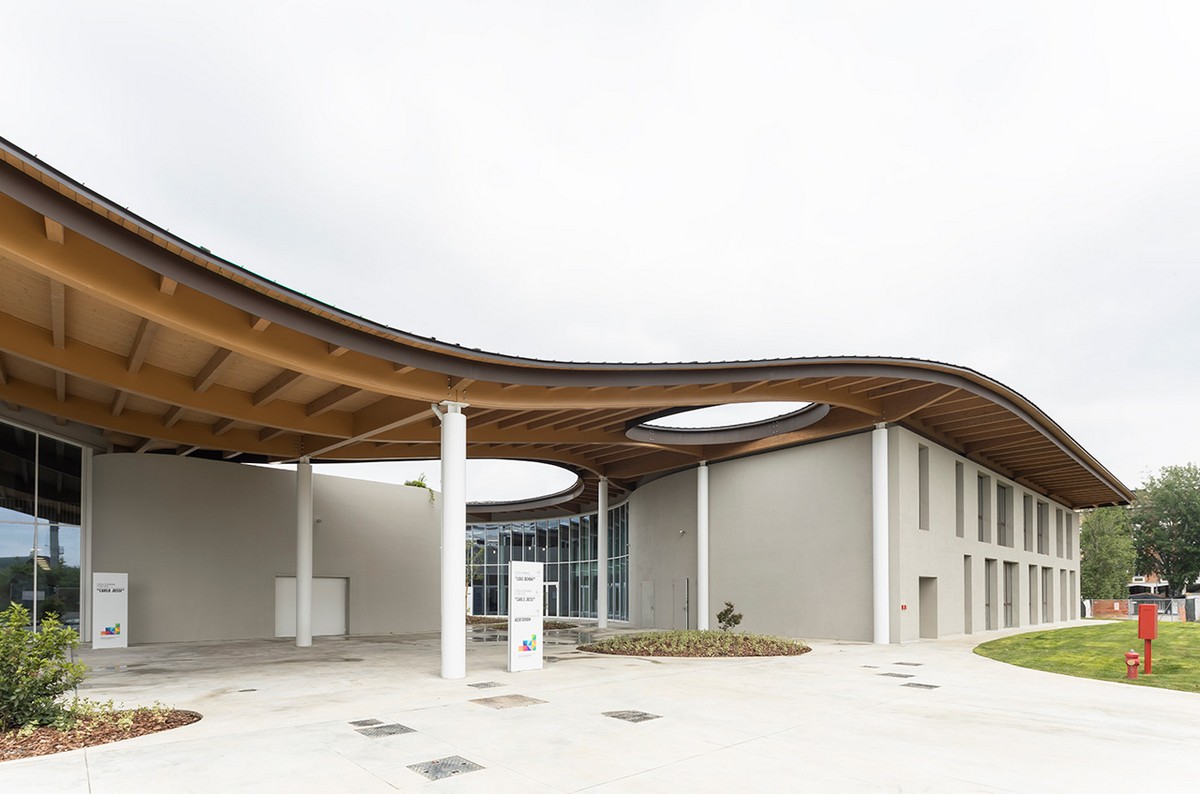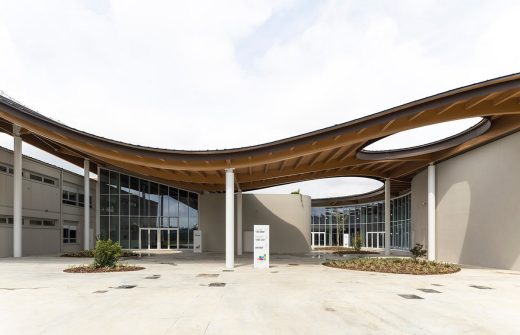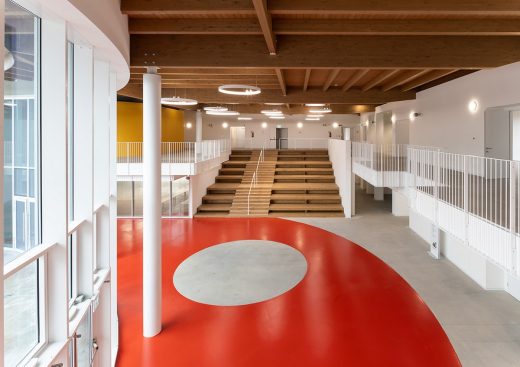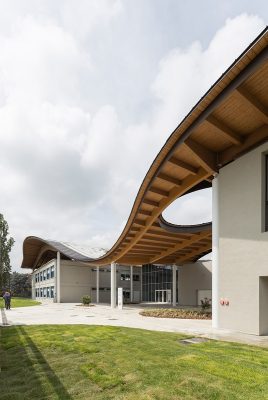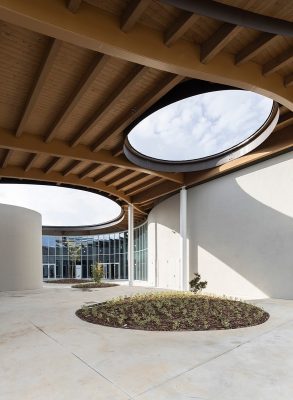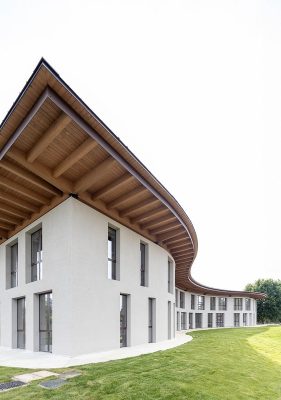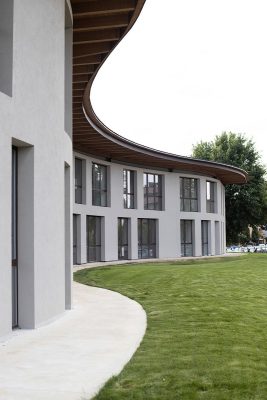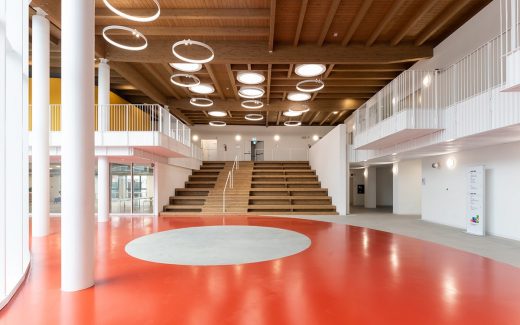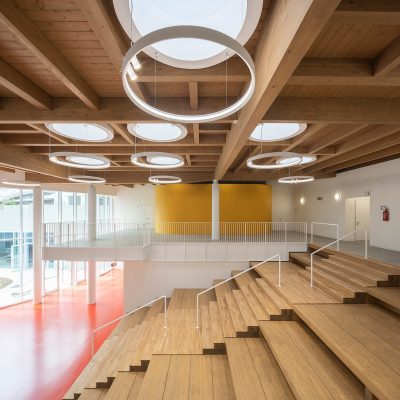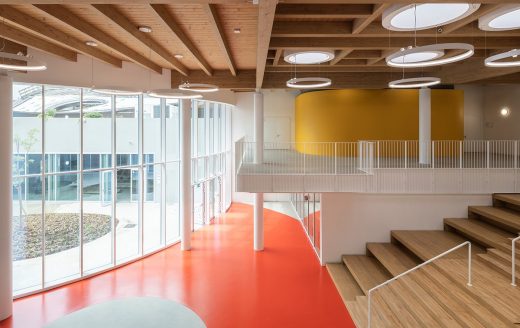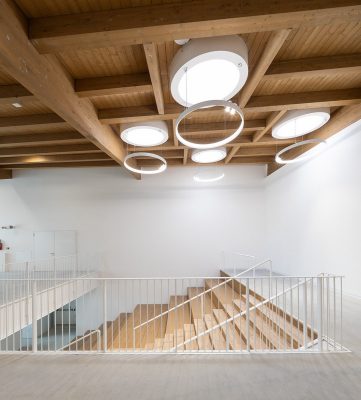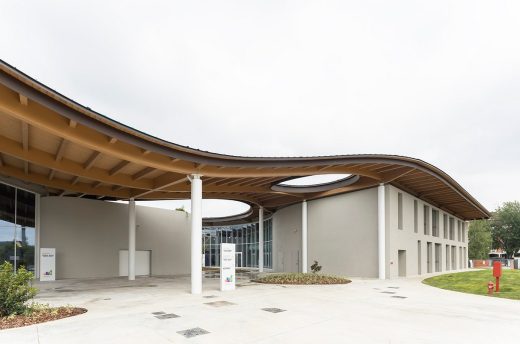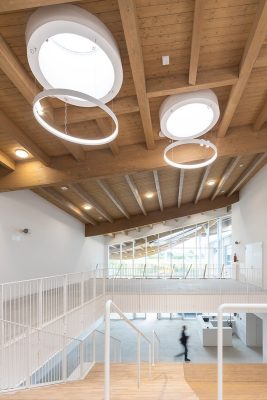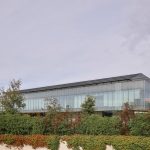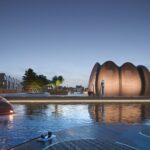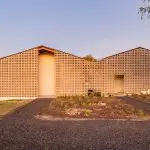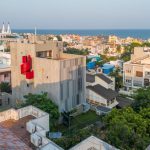Campus KID San Lazzaro Italy, Bologna school building, Italian education architecture photos
Campus KID San Lazzaro in Bologna
9 May 2024
Design: Mario Cucinella Architects
Location: Bologna, Northern Italy
Photos by Walter Vecchio
Campus KID San Lazzaro, Italy
The new Campus KID schools complex, an educational centre for children aged 6-14, is situated at the foot of the hills on the south-eastern boundary of the municipality of San Lazzaro di Savena (Bologna). This location makes it a significant element that connects the town of San Lazzaro with the surrounding area, and responds to the fragmentation of a locality where various types of services and buildings coexist.
The primary school (6-11 years old) has 20 classrooms, laboratories, and special classrooms, and can accommodate up to 500 children.
The middle school (11-14 years old) reuses the existing building, which has 18 classrooms and laboratories; a later extension designed by MCA provides additional laboratories and music classrooms. The secondary school can accommodate up to 450 pupils.
Concept
The project uses high-quality architectural design to create a unified complex (schools, gymnasium, auditorium) that connects the new building to the existing urban and territorial system as a facility that is open to the community and that harmonises with the town park. This provides healthy outdoor and indoor spaces and makes the most of the potential that the site offers to improve environmental comfort, whilst minimising energy consumption and maximising the passive energy strategies in a building where the architecture integrates the building services with the structural and technological components, and can respond strategically so that upgrading and construction can be carried out over time, in stages.
Comfort for children
Colours, light, dynamic and flexible spaces, courtyards, gardens, and contact with nature: these ingredients provide an ideally reassuring environment where younger children and middle school children can grow intellectually and physically.
The “suspended sheet”
The most strongly characterising element of the architecture is the large roof, whose strong formal presence adds strength and definition to the identity of the campus: suspended overhead like a protective sheet, it gathers together all the functions of the complex, creating continuity between all the different functional spaces and enabling them to work together in a complementary way as a unified entity that looks and feels like a single building.
The Agora
The real focus is the large central Agora: a circular area that welcomes the children as they pass from the entrance and arrive into this contained, safe, open-air space. From here they can move on to the other functions within the two buildings of the school.
After hours when normal classes are over, the Agora can continue to serve as the main entrance to the spaces that are used by the community such as the auditorium, the dining hall, and the multifunctional classrooms (which can host meetings for associations and extracurricular activities for the children).
The spaces
The two school buildings are organised to generate spaces where the child is ‘accompanied’ from primary school to secondary school on his or her personal growth path. The layout of the complex does not generate corridors: the relational space is an inclusive and flexible space that embraces and integrates with the normal and special teaching environments, as well as with the common areas and those serving the community.
This configuration guarantees a differentiated offer of services and functions that is not limited to responding only to school activities. By managing the spaces in ways that adapt to the different types of users and the different times of day, the complex becomes a socio-cultural tool where the architecture itself is a vehicle of communication and knowledge for those who use it.
An architecture that offers new scenarios for teaching and learning
The design of the school spaces responds to the need to diversify teaching and the need to offer new scenarios for teaching and learning that refer to three fundamental elements, the first of which is relationship and sharing. The second foundational element is laboratory work.
The primary school stands out for the way in which it provides a dynamic intersection of thematic and multi-purpose workshop spaces and by a dialogue/interplay between indoor and outdoor places, which makes it particularly conducive to various exploration activities, individual and group study, and recreation: there is a library, an art lab, a multimedia lab, and a science lab. The third element is polyvalence, which enables the different rooms to take on different and flexible connotations throughout the day and can therefore be used at any time to host different activities.
Other characterising elements are the four music classrooms and, as an element that is independent from the rest of the school building, the auditorium.
The new spaces for sports are particularly important: the triple gymnasium is flexible and can be subdivided to create different types of play areas whilst the service areas (changing rooms, spectator bleachers, storage, and plantrooms) act as support for the sports activities. These facilities will be used not only by the pupils, but also outside school hours by local sports clubs. The main play areas will be validated by CONI (the Italian National Olympic Committee).
The landscape project
The landscaping project for the open spaces of the complex extends beyond the school area itself and will be enlarged, at the fourth construction stage, to include a reserved teaching area and a public park. The aim is to create a basic “green structure” that facilitates contact with nature and learning within nature; an educational garden with two separate thematic areas that can be used both for learning and recreation.
They are configured differently but are both used for teaching; one has natural tree trunk seating on coloured rubber flooring and the other has auditorium seating on grass, so that the children are always in contact with natural surroundings. The two play areas have different types of natural flooring, one of sand and the other wood chips, to provide two different experiences. There will also be a teaching area with vegetable gardens, greenhouses, and a small orchard where the pupils, supported by their teachers, will be able to cultivate whatever plants they like.
So these open spaces are not only designed for teaching and learning; they also provide comfortable and aesthetically gratifying surroundings in which infants, teenagers, and young adults can take time to recharge their energies after classes.
The aim of using indigenous and ‘naturalised’ species for the newly planted trees and shrubs is to create the perception of a ‘landscape’ that resembles as closely as possible the landscape that can still be seen in some parts of the flat countryside around Bologna and, more frequently, in the hills. This ‘landscape’ significantly enhances the biodiversity in the local area; moreover, because the new plants are all deciduous, their presence helps to mitigate solar radiation during the summer and ensures that natural daylight can still be enjoyed in winter.
“Buildings must make room for new ideas and cater to new needs. Therefore, spaces for education and culture need to be regulated by a policy that is attentive to these aspects for the true relaunch of our country. For too long, educational spaces have had to respect legal norms, that do not necessarily ensure quality, let alone beauty. Buildings are always a form of education, schools even more so.”
Mario Cucinella, Founder & Design Director at MCA – Mario Cucinella Architects
Campus KID San Lazzaro in Bologna, Italy – Building Information
Architecture: Mario Cucinella Architects – https://www.mcarchitects.it/
Location: San Lazzaro di Savena (Bo)
Year: 2024
Type: Education
Client: Municipality of San Lazzaro di Savena
Area: 8,400 sqm
Project Team
Mario Cucinella
Design Leader: Tommaso Bettini
Project Director: Marco Dell’Agli, Cecilia Patrizi, Giulio Desiderio
Project Leader: Ulrich Seum, Luca Vernocchi, Luca Sandri
Architects: Silvia Conversano, Francesca Fabiana Fochi, Laura La Mendola, Alessio Naldoni, Simone Papucci, Maria Pazzaglia, Martina Ruini, Valerio Vincioni, Augusta Zanzillo
R&D Specialist: Andrea Rossi
Landscape Design: Roberto Bacchilega
Computational: Roberto Guidi
Senior Visual Artist Specialist: Walter Vecchio
Photo: Walter Vecchio
Consultants
Structural design, electrical systems, and special installations and safety coordination: Tommaso Pazzaglia, Engineer
Design of fire prevention system: Christian Zambonini, Architect
Geologist: Claudio Preci
Energy/environmental expert: Cosimo Marinosci, Engineer
Contractor for stages 1 and 2. Operational phase: RTI with parent company Ahrcos (construction works), with Sistem (timber structures), INCI (metal structures), MEI (building services)
About: MCA – Mario Cucinella Architects
Founded by Mario Cucinella in 1992 in Paris, MCA – Mario Cucinella Architects currently has offices in Bologna and Milan and consists of more than 100 professionals. Making use of its own internal R&D Department, which carries out research on sustainability issues, MCA specialises in architectural design that integrates environmental and energy strategies. The practice has completed projects in Europe, China, Africa, the Middle East, and South America.
They include a new art museum for the Fondazione Luigi Rovati in Milan; a new surgery and emergency healthcare centre for the San Raffaele Hospital in Milan; the Church of Santa Maria Goretti in Mormanno; the new Rector’s Office for Roma Tre University in Rome; One Airport Square in Accra, (Ghana); the new headquarters for NICE in Limeira (Brazil); and the Sino-Italian Ecological and Energy Efficient Building, in Beijing (China).
At present the practice is engaged on approximately 50 other projects including in Milan, the masterplan of the MIND – Milano Innovation District, the SeiMilano mixed-use project, and the Unipol Group Headquarters; the Valle D’Aosta University Campus in Aosta; The Italian Pavilion at Expo 2025 Osaka; the two mixed-use “Viertel Zwei” towers in Vienna; and the MET Tirana Building in Tirana. MCA collaborates with the SOS – School of Sustainability Foundation, a school based on an open, holistic, and research-driven approach that gives young design professionals and recent graduates the necessary tools for addressing environmental issues. The school was founded in 2015 by Mario Cucinella and is based in Milan.
Photography: Walter Vecchio
Campus KID San Lazzaro, Bologna, Italy images / information received 090524 from MCA – Mario Cucinella Architects
Location: Bologna, Emilia-Romagna region, Northern Italy.
Bologna Building Designs
Bologna Architecture Designs – key architectural selection from Emilia Romagna, North-central Italy on e-architect below:
Facade of Basilica San Petronio – Wall as a Center
Design: Inter-Esse Studio
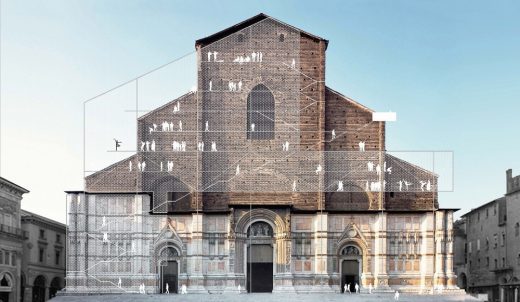
image © IES
Basilica San Petronio, Bologna
Bologna Central Station Building
Design: Andrea Maffei Architects
Bologna Central Station: Italy Building
Bologna Civic Offices Building
Design: Mario Cucinella Architects Srl
Bologna Civic Offices
MAST Foundation Bologna
Design: Labics
MAST Building Bologna
Tecnopolo Bologna
Design: gmp · von Gerkan, Marg and Partners · Architects
Bologna Technology Center Building
Italian Architecture
Italian Architecture Designs – chronological list
Complesso Parrocchiale S Paolo, Foligno
Design: Massimiliano Fuksas, Doriana Fuksas / Massimiliano Fuksas Architecture
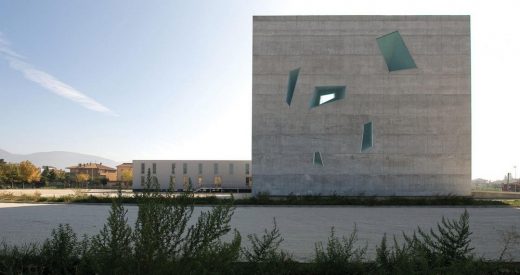
photograph : Moreno Maggi
San Paolo Parish Complex Foligno
Italian Buildings
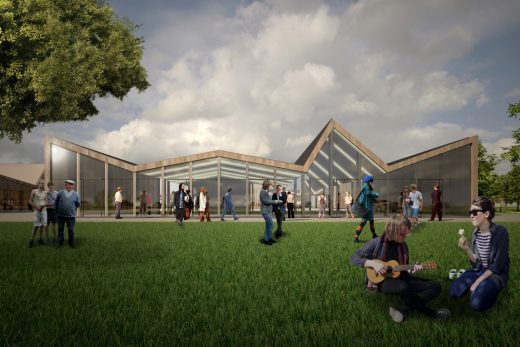
image courtesy of architects
Comments / photos for the Campus KID San Lazzaro in Bologna, Italy building design by Mario Cucinella Architects page welcome.

